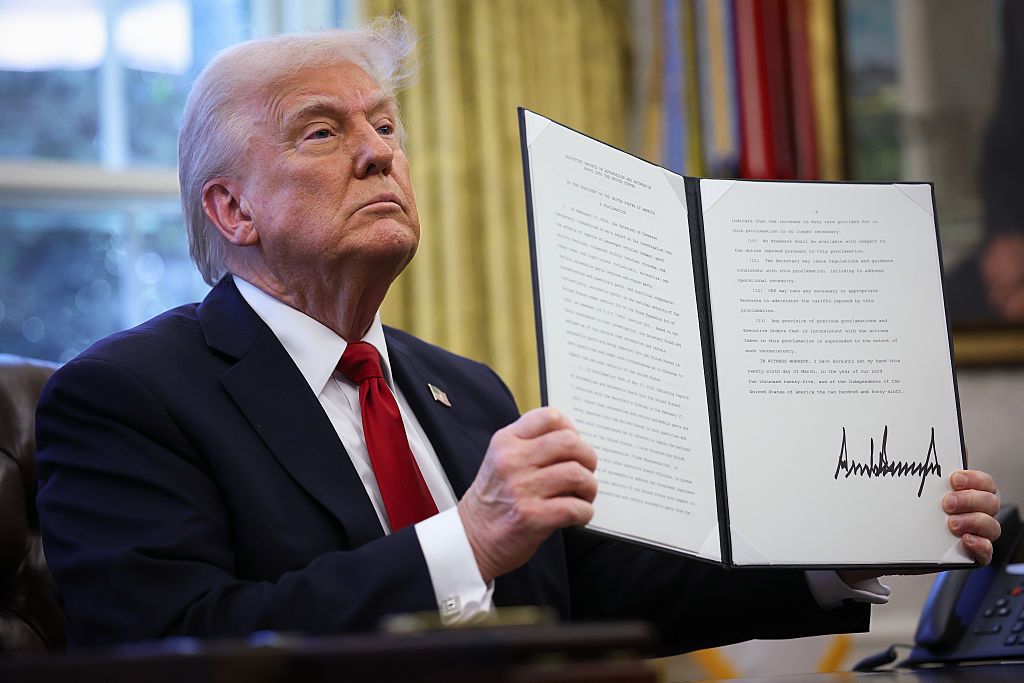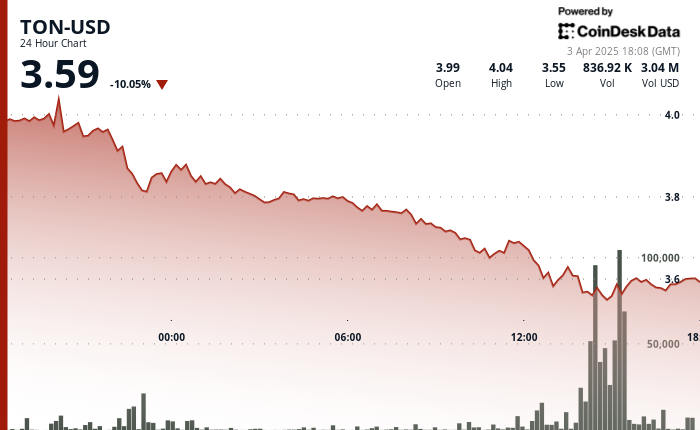Markets
Why Trump’s Tariffs Could Actually be Good for Bitcoin
Published
3 days agoon
By
admin

So far, crypto markets haven’t behaved as expected under the Trump Administration. Investors hoped that regulatory reform and policies like a Bitcoin Strategic Reserve would drive prices appreciably higher. But it’s been the opposite. Bitcoin has fallen from highs well above $100,000 at the beginning of the year to a trough in the mid-80,000s for most of March.
Crypto prices have suffered from being increasingly correlated with traditional assets like stocks and bonds, which have been hit by macroeconomic uncertainty. Tariffs — surcharges the U.S. places on imports from other countries — have Wall Street worried about a global recession. Crypto investors have been steering clear of crypto assets, which are seen as relatively risky.
“This is all about markets’ ‘risk appetite’ which continues to deteriorate, and for the time being drives a wedge between crypto assets and gold, which continues to be the ‘safe haven’ of choice,” said Marc Ostwald, Chief Economist & Global Strategist at ADM Investor Services International.
“[That’s] in no small part driven by central bank FX reserve managers, who are seeking to reduce USD exposure, which has long been a source of concern to them.”
As the global financial and trade system becomes more fragmented, investors are seeking alternatives to riskier assets, including dollars. For now, that means turning to gold, which is up 18% year-to-date.
But that could change, said Omid Malekan, an adjunct professor at Columbia Business School and author of “The Story of the Blockchain: A Beginner’s Guide to the Technology That Nobody Understands.” Bitcoin could be the new gold soon enough.
“I think the entire [future] is uncertain and in some ways unknowable, because there are many crosscurrents and both crypto and tariffs are new. Some people argue that crypto is just a risk-on tech asset and would sell off due to tariffs. But bitcoin has found footing in some circles as ‘digital gold’ and the physical variety is soaring on the tariff news. So which will it be?”
In other words, economic uncertainty could lead investors to seek out bitcoin just as they have sought out gold in recent months.
Another note of positivity: the impact of tariffs on crypto could be “priced in” and the worst might be over already, said Zach Pandl, head of research at Grayscale, a leading crypto asset management firm.
President Trump is due to announce U.S. tariffs on Wednesday, April 2, at 4 p.m. ET—what’s known as “Liberation Day.” According to reports, he’ll lay out “reciprocal tariffs” against 15 countries that have levied tariffs against the U.S., including China, Canada and Mexico.
Pandl estimates tariffs have so far taken 2% off economic growth this year. But Liberation Day might actually stop the worst of the pain felt in financial markets. “If we see an announcement [on Wednesday] that is tough but phased, and focused on the 15 countries they seem to be targeting, my expectation is that markets will rally on that news,” Pandl told CoinDesk.
“Potentially once we get through this announcement, crypto markets can focus back on the fundamentals which are very positive.”
Pandl said announcements like Circle’s IPO wouldn’t be happening if institutions didn’t have a high degree of confidence in the digital assets sector and the policies around it.
Moreover, Pandl, a former macro-economist at Goldman Sachs, believes that tariffs will increase the appetite for currencies that aren’t dollars.
“I think tariffs will weaken the dominant role of the dollar and create space for competitors including bitcoin. Prices have gone down in the short run. But the first few months of the Trump Administration have raised my conviction in the longer term for bitcoin as a global monetary asset.”
Pendl still believes that bitcoin will hit new all-time highs this year, despite current pessimism around prices. “I wouldn’t have quit my Wall Street job if I didn’t think bitcoin will be the winner in the long term,” he said.
Source link
You may like


Crypto Trader Says Dogecoin Is at a Critical ‘Make-or-Break’ Level, Updates Outlook on Solana and Avalanche


Bitcoin Covenants: CHECKSIGFROMSTACK (BIP 348)


Illinois State Senator’s Bill Seeks to Claw Back $163 Million Lost to Crypto Fraud


Here’s why Bitcoin, altcoins, and the stock market continued falling on Friday


Bitcoin Falls Back to $83K, XRP, SOL, DOGE Surrender Gains as China Announces 34% Tariffs on All U.S. Goods


BTC Holds $84K, ATOM & FIL Become Top Gainers
Altcoin
Here’s why Bitcoin, altcoins, and the stock market continued falling on Friday
Published
3 hours agoon
April 4, 2025By
admin

Bitcoin, altcoins, and the stock market continued their downward trend on Friday as the trade war between the U.S. and China escalated.
Bitcoin (BTC) price dropped to $82,000, erasing some of the gains made during the Asian and European markets. Ethereum (ETH) dropped below $1,800, while the market cap of all coins fell to $2.64 trillion.
The stock market’s performance was even worse as futures tied to the Dow Jones, S&P 500, and Nasdaq 100 indices plunged by over 3%. This means that these blue-chip indices have all moved into a correction.
Trade war escalates
Bitcoin, altcoins, and equities declined after China announced its retaliatory measures against the U.S. In a statement, Beijing said it would impose a 34% tariff on all goods imported from the U.S.
In addition, China will restrict exports of certain rare earth minerals, halt sorghum imports from U.S. companies, and add 11 American firms to its unreliable entity list.
These measures mark the most significant response to Donald Trump’s Liberation Day tariffs. Other countries, especially those in Europe, have called for negotiations to prevent the trade war from expanding.
Trump and senior officials have warned that the U.S. will deliver reciprocal tariffs on any country that retaliates. They’ve urged trading partners to lower their tariffs and non-tariff barriers instead.
Therefore, Bitcoin, altcoins, and the stock market are falling as these actions lead to higher odds of a recession. Polymarket data shows that traders have boosted their recession odds to 56%. Companies like Goldman Sachs and PIMCO have also boosted their recession odds.
These fears have pushed market sentiment into extreme territory. The CNN Money Fear and Greed Index dropped to 6, the lowest reading since the onset of the COVID-19 pandemic.
Investor pessimism intensified after billionaire and former Bond King Bill Gross warned against buying the dip. He said:
“Investors should not try to ‘catch a falling knife. This is an epic economic and market event similar to 1971 and the end of the gold standard except with immediate negative consequences.”
Bitcoin, altcoins, and the stock market fall after NFP data
Markets also weakened after the U.S. released the latest nonfarm payrolls (NFP) report. The data showed that unemployment rose to 4.2% in March, up from 4.1% in February.
The economy added 228,000 jobs, beating analysts’ median forecast of 137,000. However, the manufacturing sector, which Trump aims to protect with his tariff policy, created just 1,000 jobs.
These figures will likely have minimal impact on the Federal Reserve, which remains focused on inflation and GDP growth.
Meanwhile, the bond market is signaling expectations of lower interest rates. The 10-year Treasury yield fell to 3.89%, while the 30-year and 2-year yields declined to 4.38% and 3.5%, respectively. If the Fed cuts rates, it would likely be bullish for Bitcoin, altcoins, and the broader stock market.
Source link
Bitcoin
Bitcoin Falls Back to $83K, XRP, SOL, DOGE Surrender Gains as China Announces 34% Tariffs on All U.S. Goods
Published
5 hours agoon
April 4, 2025By
admin

Risk sentiment worsened during the European hours Friday after China announced retaliatory tariffs on all goods, responding to Trump’s Wednesday decision to boost the overall levy on Chinese goods to 54%.
Bitcoin, the leading cryptocurrency by market value, fell by $1,600 to $83,000, erasing the early rise to $84,600, CoinDesk data shows. Other tokens like XRP, ETH, SOL and DOGE also reversed early gains to trade largely flat on the day.
Meanwhile, futures tied to the S&P 500 and Nasdaq fell over 2% amid escalating global trade tensions.
“China’s response is not only negative for the U.S. but it is also impacting the global outlook,” ForexLive’s analyst Justin Low wrote in a market update.
Source link
AI Market Insights
Toncoin’s (TON) Dramatic Volatility Signals Market Uncertainty
Published
21 hours agoon
April 3, 2025By
admin

Market Recovery Amid Institutional Confidence
The cryptocurrency market remains in turbulent territory as Toncoin (TON) demonstrates both significant volatility and remarkable resilience.
After forming a head-and-shoulders pattern with strong resistance at $4.15, TON has recovered from its recent lows. It is now trading at $4.13 with a 12.5% weekly gain.
This recovery comes amid news that leading venture capital firms, including Sequoia, Ribbit Capital, and Benchmark, collectively hold over $400 million in TON, signaling institutional confidence in the blockchain’s future.
TON Technical Analysis Highlights
- Price action formed a head-and-shoulders pattern with resistance at $4.15 and support at $3.60.
- The support level at $3.60 was breached during the April 3rd selloff.
- Volume analysis shows distribution phases coinciding with price peaks, suggesting institutional profit-taking.
- Fibonacci retracement indicates potential stabilization around the 0.618 level at $3.58.
- Cup-and-handle formation appeared during recovery with initial resistance at $3.58.
- Strong buying pressure was observed during the 15:32-15:34 and 15:58 periods.
- Price reclaimed the Fibonacci 0.382 level at $3.59, suggesting potential continuation toward $3.65.
Disclaimer: This article was generated with AI tools and reviewed by our editorial team to ensure accuracy and adherence to our standards. For more information, see CoinDesk’s full AI Policy. This article may include information from external sources, which are listed below when applicable.
- TheNewsCrypto, “Toncoin (TON) Eyes $4 as Bullish Momentum Builds,” accessed April 3, 2025
- CryptoNews, “Is This the Next Solana? Toncoin’s $400 Million VC Investment Surge Signals Explosive Upside,” accessed April 3, 2025
- CryptoDaily, “AI Predicts 12,500% Gains for Remittix (RTX), 232% for Chainlink (LINK) — But to Sell Toncoin (TON), Shiba Inu (SHIB) Fast,” accessed April 3, 2025
- TheNewsCrypto, “Toncoin (TON) Price Prediction,” accessed April 3, 2025
- Bitcoin Sistemi, “Top Crypto Platforms: Binance Coin, BlockDAG, Tron, Toncoin Poised for Major Growth in 2025,” accessed April 3, 2025
Source link

Crypto Trader Says Dogecoin Is at a Critical ‘Make-or-Break’ Level, Updates Outlook on Solana and Avalanche

Bitcoin Covenants: CHECKSIGFROMSTACK (BIP 348)

Illinois State Senator’s Bill Seeks to Claw Back $163 Million Lost to Crypto Fraud

Here’s why Bitcoin, altcoins, and the stock market continued falling on Friday

Bitcoin Falls Back to $83K, XRP, SOL, DOGE Surrender Gains as China Announces 34% Tariffs on All U.S. Goods

BTC Holds $84K, ATOM & FIL Become Top Gainers

Analysts Eye 20% Breakout If This Level Is Reclaimed

AI and blockchain — A match made in heaven

‘We’re Still in Danger Territory’: Crypto Analyst Unveils Bearish Setup for Bitcoin – Here Are His Targets

Bitcoin Startups Raised Nearly $1.2 Billion

Illinois to End Lawsuit Against Coinbase Over Staking Program: Report

Justin Sun takes legal action against FDUSD issuer
Not a Meme! DePIN Can Take Crypto Mainstream

Cardano Price Can Clinch $1 As It Eyes Bounce From New Support Zone

Glassnode Finds XRP Is Retail’s Top Pick This Cycle

Arthur Hayes, Murad’s Prediction For Meme Coins, AI & DeFi Coins For 2025

Expert Sees Bitcoin Dipping To $50K While Bullish Signs Persist

Aptos Leverages Chainlink To Enhance Scalability and Data Access

Bitcoin Could Rally to $80,000 on the Eve of US Elections

Sonic Now ‘Golden Standard’ of Layer-2s After Scaling Transactions to 16,000+ per Second, Says Andre Cronje

Institutional Investors Go All In on Crypto as 57% Plan to Boost Allocations as Bull Run Heats Up, Sygnum Survey Reveals

Crypto’s Big Trump Gamble Is Risky

Ripple-SEC Case Ends, But These 3 Rivals Could Jump 500x

Has The Bitcoin Price Already Peaked?

A16z-backed Espresso announces mainnet launch of core product

Xmas Altcoin Rally Insights by BNM Agent I

Blockchain groups challenge new broker reporting rule

The Future of Bitcoin: Scaling, Institutional Adoption, and Strategic Reserves with Rich Rines

Trump’s Coin Is About As Revolutionary As OneCoin

Is $200,000 a Realistic Bitcoin Price Target for This Cycle?
Trending

 24/7 Cryptocurrency News5 months ago
24/7 Cryptocurrency News5 months agoArthur Hayes, Murad’s Prediction For Meme Coins, AI & DeFi Coins For 2025

 Bitcoin3 months ago
Bitcoin3 months agoExpert Sees Bitcoin Dipping To $50K While Bullish Signs Persist

 24/7 Cryptocurrency News3 months ago
24/7 Cryptocurrency News3 months agoAptos Leverages Chainlink To Enhance Scalability and Data Access

 Bitcoin5 months ago
Bitcoin5 months agoBitcoin Could Rally to $80,000 on the Eve of US Elections

 Altcoins2 months ago
Altcoins2 months agoSonic Now ‘Golden Standard’ of Layer-2s After Scaling Transactions to 16,000+ per Second, Says Andre Cronje

 Bitcoin5 months ago
Bitcoin5 months agoInstitutional Investors Go All In on Crypto as 57% Plan to Boost Allocations as Bull Run Heats Up, Sygnum Survey Reveals

 Opinion5 months ago
Opinion5 months agoCrypto’s Big Trump Gamble Is Risky

 Price analysis5 months ago
Price analysis5 months agoRipple-SEC Case Ends, But These 3 Rivals Could Jump 500x


